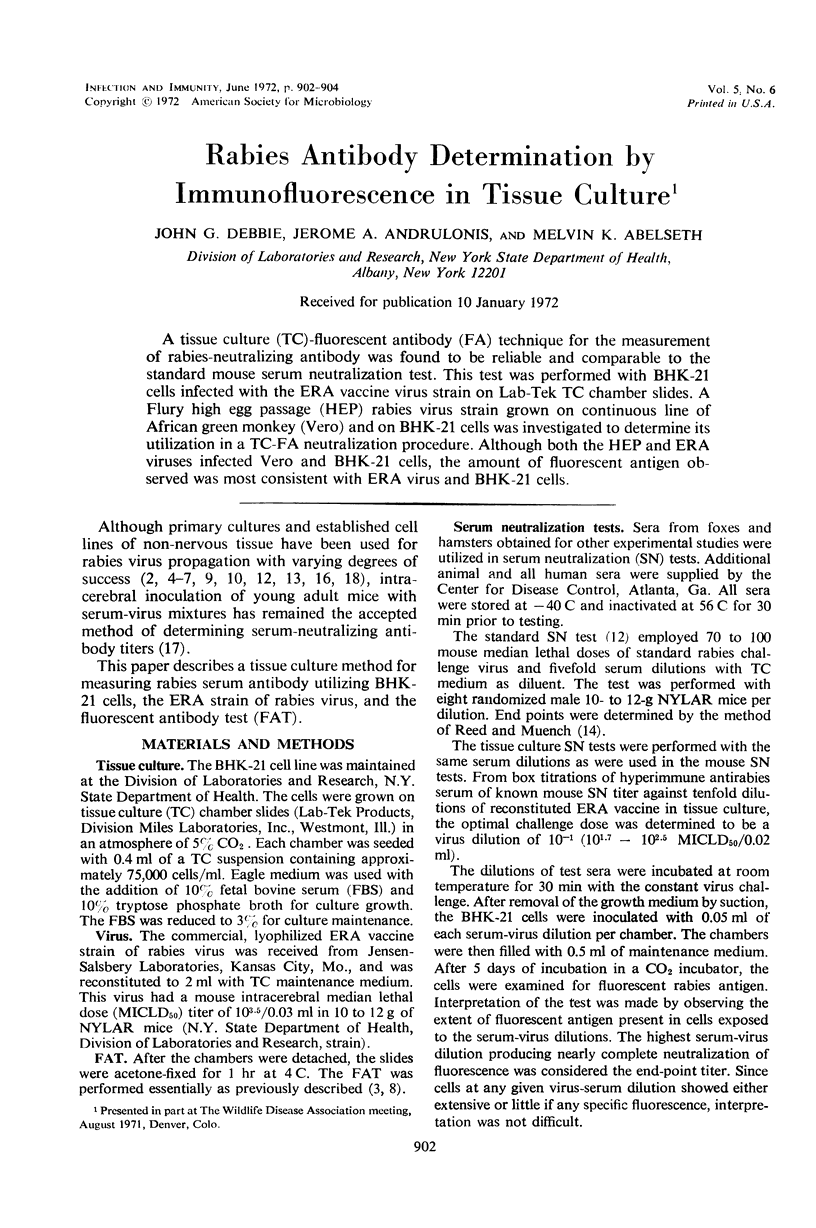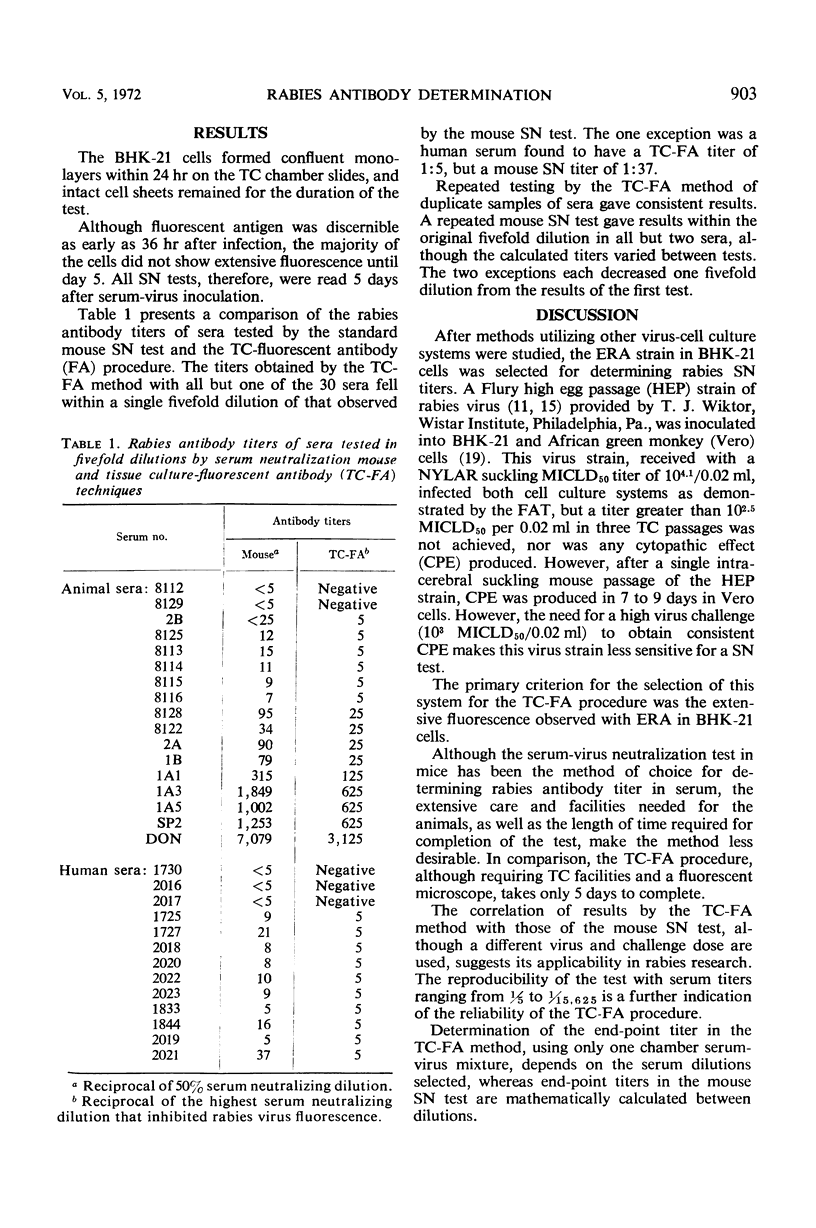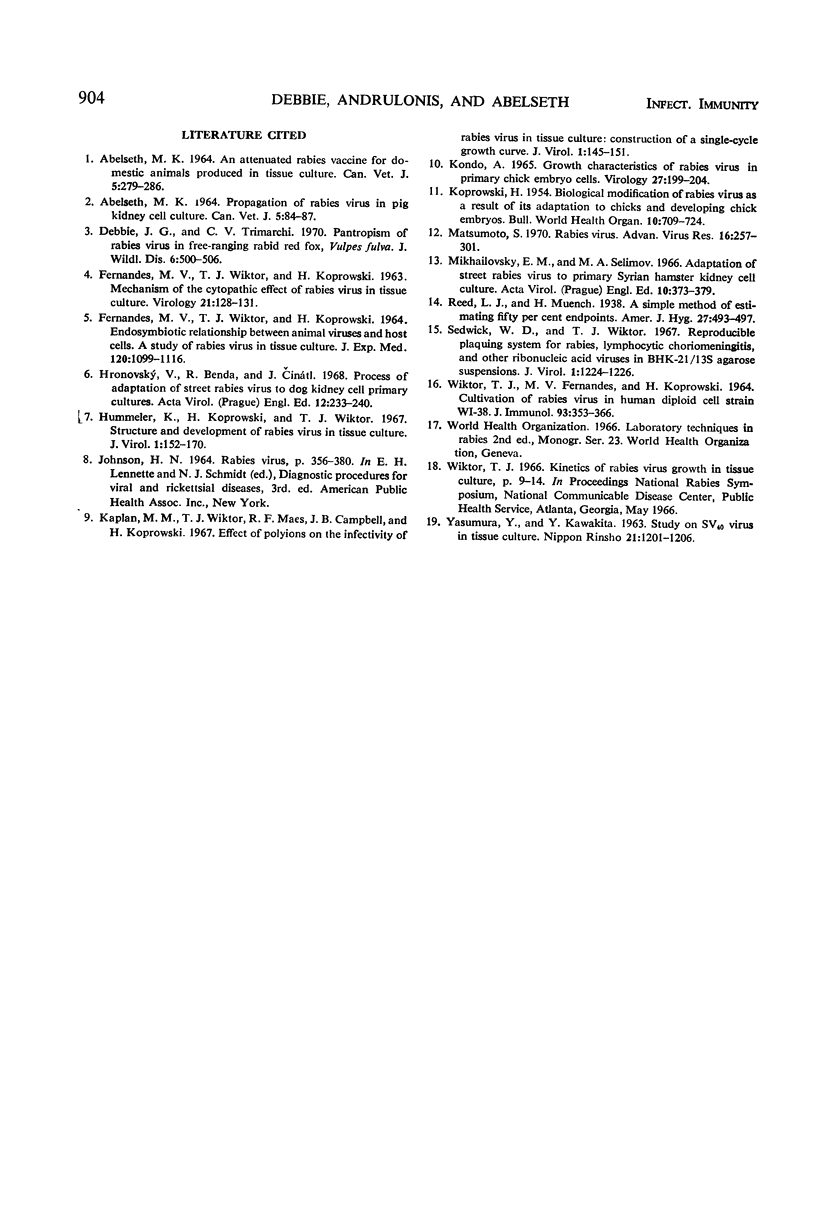Abstract
A tissue culture (TC)-fluorescent antibody (FA) technique for the measurement of rabies-neutralizing antibody was found to be reliable and comparable to the standard mouse serum neutralization test. This test was performed with BHK-21 cells infected with the ERA vaccine virus strain on Lab-Tek TC chamber slides. A Flury high egg passage (HEP) rabies virus strain grown on continuous line of African green monkey (Vero) and on BHK-21 cells was investigated to determine its utilization in a TC-FA neutralization procedure. Although both the HEP and ERA viruses infected Vero and BHK-21 cells, the amount of fluorescent antigen observed was most consistent with ERA virus and BHK-21 cells.
Full text
PDF


Selected References
These references are in PubMed. This may not be the complete list of references from this article.
- Abelseth M. K. An Attenuated Rabies Vaccine for Domestic Animals Produced in Tissue Culture. Can Vet J. 1964 Nov;5(11):279–286. [PMC free article] [PubMed] [Google Scholar]
- Debbie J. G., Trimarchi C. V. Pantropism of rabies virus in free-ranging rabid red fox Vulpes fulva. J Wildl Dis. 1970 Oct;6(4):500–506. doi: 10.7589/0090-3558-6.4.500. [DOI] [PubMed] [Google Scholar]
- FERNANDES M. V., WIKTOR T. J., KOPROWSKI H. ENDOSYMBIOTIC RELATIONSHIP BETWEEN ANIMAL VIRUSES AND HOST CELLS. A STUDY OF RABIES VIRUS IN TISSUE CULTURE. J Exp Med. 1964 Dec 1;120:1099–1116. doi: 10.1084/jem.120.6.1099. [DOI] [PMC free article] [PubMed] [Google Scholar]
- FERNANDES M. V., WIKTOR T. J., KOPROWSKI H. MECHANISM OF THE CYTOPATHIC EFFECT OF RABIES VIRUS IN TISSUE CULTURE. Virology. 1963 Sep;21:128–131. doi: 10.1016/0042-6822(63)90312-x. [DOI] [PubMed] [Google Scholar]
- Hronovský V., Benda R., Cinátl J. Process of adaptation of street rabies virus to dog kidney cell primary cultures. Acta Virol. 1968 May;12(3):233–240. [PubMed] [Google Scholar]
- Hummeler K., Koprowski H., Wiktor T. J. Structure and development of rabies virus in tissue culture. J Virol. 1967 Feb;1(1):152–170. doi: 10.1128/jvi.1.1.152-170.1967. [DOI] [PMC free article] [PubMed] [Google Scholar]
- KOPROWSKI H. Biological modification of rabies virus as a result of its adaptation to chicks and developing chick embryos. Bull World Health Organ. 1954;10(5):709–724. [PMC free article] [PubMed] [Google Scholar]
- Kaplan M. M., Wiktor T. J., Maes R. F., Campbell J. B., Koprowski H. Effect of polyions on the infectivity of rabies virus in tissue culture: construction of a single-cycle growth curve. J Virol. 1967 Feb;1(1):145–151. doi: 10.1128/jvi.1.1.145-151.1967. [DOI] [PMC free article] [PubMed] [Google Scholar]
- Kondo A. Growth characteristics of rabies virus in primary chick embryo cells. Virology. 1965 Oct;27(2):199–204. doi: 10.1016/0042-6822(65)90160-1. [DOI] [PubMed] [Google Scholar]
- Matsumoto S. Rabies virus. Adv Virus Res. 1970;16:257–301. [PubMed] [Google Scholar]
- Mikhailovsky E. M., Selimov M. A. Adaptation of street rabies virus to primary Syrian hamster kidney cell culture. Acta Virol. 1966 Jul;10(4):373–373. [PubMed] [Google Scholar]
- Sedwick W. D., Wiktor T. J. Reproducible plaquing system for rabies, lymphocytic choriomeningitis,k and other ribonucleic acid viruses in BHK-21-13S agarose suspensions. J Virol. 1967 Dec;1(6):1224–1226. doi: 10.1128/jvi.1.6.1224-1226.1967. [DOI] [PMC free article] [PubMed] [Google Scholar]
- WIKTOR T. J., FERNANDES M. V., KOPROWSKI H. CULTIVATION OF RABIES VIRUS IN HUMAN DIPLOID CELL STRAIN WI-38. J Immunol. 1964 Sep;93:353–366. [PubMed] [Google Scholar]


